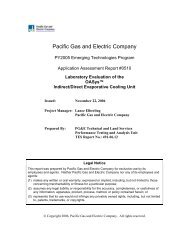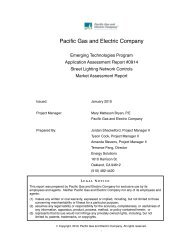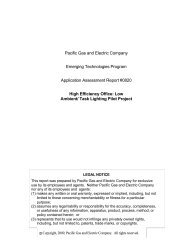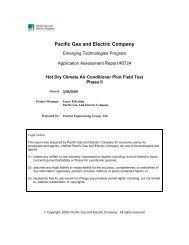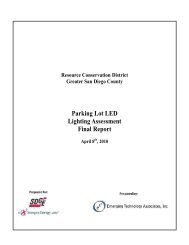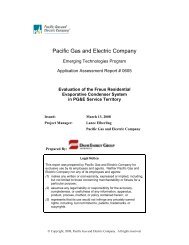Download the project report.
Download the project report.
Download the project report.
You also want an ePaper? Increase the reach of your titles
YUMPU automatically turns print PDFs into web optimized ePapers that Google loves.
The manufacturer requires that <strong>the</strong> bottom element of <strong>the</strong> existing electric water heater be disabled so as<br />
not to override <strong>the</strong> heat pump coil. The upper element may be left active to provide quick heat to <strong>the</strong><br />
upper part of <strong>the</strong> tank during large use events, or it may also be disabled as well to ensure high efficiency<br />
operation with just <strong>the</strong> heat pump. (Electric resistance water heaters typically have upper and lower<br />
heating elements that operate alternately depending on which one’s <strong>the</strong>rmostat is activated; for most draw<br />
events only <strong>the</strong> lower element will operate.)<br />
There were fewer tests conducted on this unit as <strong>the</strong> result of a number of errors unrelated to <strong>the</strong> HPWH<br />
itself. Upon heater startup, <strong>the</strong> electric resistance element was showing a low power draw even though it<br />
was supposed to be off. Ei<strong>the</strong>r through a manufacturing defect or because <strong>the</strong> element may have been<br />
activated without water, <strong>the</strong> upper heating element had failed and passing current to ground through <strong>the</strong><br />
water. While <strong>the</strong> system could (and would mainly) be tested without supplemental resistance heat, it was<br />
desired to include it as more representative of <strong>the</strong> typical installation. In case it might have been<br />
damaged, <strong>the</strong> tank temperature <strong>the</strong>rmocouple array inserted through <strong>the</strong> anode rod penetration was also<br />
removed for inspection. Unfortunately, <strong>the</strong> <strong>the</strong>rmostat for <strong>the</strong> heat pump had become tangled in <strong>the</strong><br />
<strong>the</strong>rmocouples, and broke off when <strong>the</strong>y were removed. Thus, <strong>the</strong> evaluation unintentionally<br />
demonstrated that <strong>the</strong> system <strong>the</strong>rmostat can be replaced without affecting <strong>the</strong> o<strong>the</strong>r system components.<br />
All of <strong>the</strong> test results for this unit are from after <strong>the</strong> <strong>the</strong>rmostat replacement and installation of a new<br />
heating element in <strong>the</strong> tank.<br />
As an add-on unit ra<strong>the</strong>r than a system, <strong>the</strong> AirTap does not have official performance ratings listed, and<br />
<strong>the</strong> overall system performance will depend on <strong>the</strong> efficiency and capacity of <strong>the</strong> attached water tank. A<br />
test <strong>report</strong> from GAMA was provided with <strong>the</strong> unit listing an Energy Factor of 2.11 and a first hour rating<br />
of 42.5, but it does not say how large of a storage tank was used.<br />
Rheem HP50<br />
This is a new product design of an integrated heat pump system with supplemental resistance heat. In this<br />
system, all of <strong>the</strong> heat pump components including <strong>the</strong> condenser are located on top of <strong>the</strong> tank, and water<br />
is circulated by a pump loop that draws water from <strong>the</strong> bottom of <strong>the</strong> tank, through <strong>the</strong> condenser, and<br />
back into <strong>the</strong> top of <strong>the</strong> tank. With this circulation, <strong>the</strong> tank water temperature stays very consistent with<br />
very little stratification. Air to <strong>the</strong> evaporator is drawn in through a round filter on top of <strong>the</strong> unit, and<br />
discharged through a coil that forms about 2/3 of a cylinder on <strong>the</strong> back side of <strong>the</strong> unit. Because of <strong>the</strong><br />
location of <strong>the</strong> heat pump components, <strong>the</strong>re are no penetrations in <strong>the</strong> top of <strong>the</strong> storage tank: <strong>the</strong> water<br />
inlet and outlet connections are on <strong>the</strong> sides. The tank also does not have an end-user serviceable<br />
sacrificial anode rod. Because <strong>the</strong>re was no top penetration, <strong>the</strong> tank temperature <strong>the</strong>rmocouple array had<br />
to be inserted using <strong>the</strong> pressure relief valve tap, while keeping this safety valve available through a tee<br />
fitting. Because <strong>the</strong> cool air discharging <strong>the</strong> evaporator is directed out and down from <strong>the</strong> top of <strong>the</strong> tank,<br />
<strong>the</strong> tank environmental temperature may be depressed, possibly resulting in an increased potential for<br />
standby loss unless <strong>the</strong> space is adequately ventilated.<br />
This unit also has resistive elements for supplemental heating; however, <strong>the</strong> element capacity is about half<br />
of that for o<strong>the</strong>r similar-sized electric water heater tanks at 2 kW each. The system is enabled with three<br />
distinct modes of operation – Normal, Energy Saver, and resistance heat only - as illustrated in Figure 6.<br />
The chart shows <strong>the</strong> overlapping trends of power consumption for <strong>the</strong> three modes following a draw in<br />
<strong>the</strong> standard Energy Factor test (~10.7 gallons at 3 gpm). In “Normal” mode, <strong>the</strong> heat pump turns on first<br />
and is allowed to heat <strong>the</strong> tank up to a certain temperature. As <strong>the</strong> water temperature rises, <strong>the</strong> heating<br />
capacity of <strong>the</strong> heat pump decreases, so one resistance element is brought on some time later to assist <strong>the</strong><br />
heat pump. Eventually, once ano<strong>the</strong>r temperature threshold is reached, <strong>the</strong> heat pump is turned off in<br />
favor of <strong>the</strong> resistive element. The “Energy Saver” mode is not all that different, o<strong>the</strong>r than allowing <strong>the</strong><br />
heat pump to run longer by itself, and <strong>the</strong>n switching over to resistance heat when needed while not<br />
allowing <strong>the</strong> two components to operate simultaneously. Thus, <strong>the</strong> Energy Saver mode not only reduces<br />
energy consumption, it also reduces <strong>the</strong> maximum power demand by about a third. The last stage of both<br />
<strong>the</strong>se modes with <strong>the</strong> resistance heat operating alone is only needed if <strong>the</strong> <strong>the</strong>rmostat is set above <strong>the</strong><br />
491-09.17.doc 14



